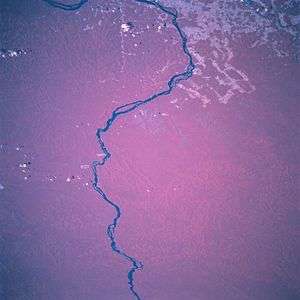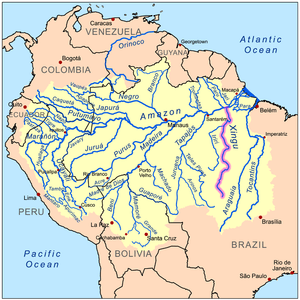Xingu River
| Xingu River | |
 Xingu river from space, downstream section. | |
| Country | Brazil |
|---|---|
| Tributaries | |
| - left | Iriri River, Pardo River |
| Mouth | Amazon River |
| - coordinates | 1°31′59″S 52°14′30″W / 1.53306°S 52.24167°WCoordinates: 1°31′59″S 52°14′30″W / 1.53306°S 52.24167°W |
| Length | 1,640 km (1,019 mi) [1] |
| Basin | 520,300 km2 (200,889 sq mi) |
| Discharge | |
| - average | 9,680 m3/s (341,846 cu ft/s) |
 Map of the Amazon Basin with the Xingu River highlighted | |
The Xingu River (Portuguese: Rio Xingu, Portuguese pronunciation: [ɕĩˈɡu], /ʃiŋˈɡuː/ sheeng-GOO) is a 1,640 km (1,019 mi)[1] river in north Brazil. It is a southeast tributary of the Amazon River.
Description and history
The first Indian Park in Brazil was created in the river basin by the Brazilian government in the early 1960s. This park marks the first indigenous territory recognized by the Brazilian government and it was the world's largest indigenous reserve on the date of its creation. Currently, fourteen tribes live on the reserve surviving with natural resources and extracting from the river most of what they need for food and water.
The Brazilian government is building the Belo Monte Dam, which will be the world's third-largest hydroelectric dam, on the Lower Xingu. Construction of this dam is under legal challenge by environment and indigenous groups, who assert the dam would have negative environmental and social impacts along with reducing the flow by up to 80% along a 100 kilometres (62 mi) stretch known as the "Big Bend" (Volta Grande).[2] More than 450 fish species have been documented in the Xingu River Basin and it is estimated that the total is around 600 fish species, including many endemics.[3] In the last 5 years alone, 21 new fish species have been described from the river.[4] Many species are seriously threatened by the dam,[5][6] including at least 26 fish species that are entirely restricted to the lower Xingu.[4]
In the Upper Xingu region was a highly self-organized pre-Columbian anthropogenic landscape, including deposits of fertile agricultural terra preta, black soil in Portuguese, with a network of roads and polities each of which covered about 250 square kilometers.[7]
Near the source of Xingu River is Culuene River, a 600 km tributary.
In popular culture
- The name is the title of a humorous Edith Wharton short story from 1911.
- "Xingu" is the title of a song on Waterfall Cities, a 1999 album by Ozric Tentacles.
- The river is also honoured in the album Aguas da Amazonia.
- A beer produced near the river is sold in the international market under the name "Xingu".
- In the novel Relic by Douglas Preston and Lincoln Child, the Xingu River is the location of the doomed Whittlesey/Maxwell expedition responsible for discovering evidence of the lost Kothoga tribe and their savage god Mbwun.
- It is the name of a Brazilian 2012 movie, directed by famous Brazilian film-maker Cao Hamburger. The movie tells the story of the Villas-Bôas brothers 1943 expedition to the region, which led to the creation of the indigenous reserve twenty years later.
See also
References
- 1 2 Ziesler, R.; Ardizzone, G.D. (1979). "Amazon River System". The Inland waters of Latin America. Food and Agriculture Organization of the United Nations. ISBN 92-5-000780-9. Archived from the original on 21 October 2013.
- ↑ "Summary and History of the Belo Monte Dam: Rainforest Foundation" (PDF). Summary and History of the Belo Monte Dam: Rainforest Foundation. Archived from the original (PDF) on 6 January 2011. Retrieved 9 March 2011.
- ↑ Camargo, M., T. Giarrizzo and V. Isaac (2004). Review of the geographic distribution of fish fauna in the Xingu River Basin, Brazil. Ecotropica 10: 123–147
- 1 2 Hyland, T: Race against time. Retrieved 4 June 2014.
- ↑ Ekström, J. (23 December 2007) Hydroelectric dam constructions in Amazonas. Retrieved 10 February 2013.
- ↑ Survival International (2009). Experts Panel Assesses Belo Monte Dam Viability. Retrieved 10 February 2013.
- ↑ Heckenberger, Michael J.; J. Christian Russell; Carlos Fausto; Joshua R. Toney; Morgan J. Schmidt; Edithe Pereira; Bruna Franchetto; Afukaka Kuikuro (2008-09-29). "Pre-Columbian Urbanism, Anthropogenic Landscapes, and the Future of the Amazon". Science. American Association for the Advancement of Science. 321 (5893): 1214–1217. doi:10.1126/science.1159769. PMID 18755979.
- Cowell, Adrian. 1973. The Tribe that Hides from Man. The Bodely Head, London.
- Original text from 1911 Encyclopædia Britannica
Further reading
- Heinsdijk, Dammis, and Ricardo Lemos Fróes. Description of Forest-Types on "Terra Firme" between the Rio Tapajós and the Rio Xingú in the Amazon Valley. 1956.
- Sipes, Ernest "Brazilian Indians: what FUNAI Won't Tell YOU". 2002.
- Brazilian Indians: What FUNAI Won't Tell You